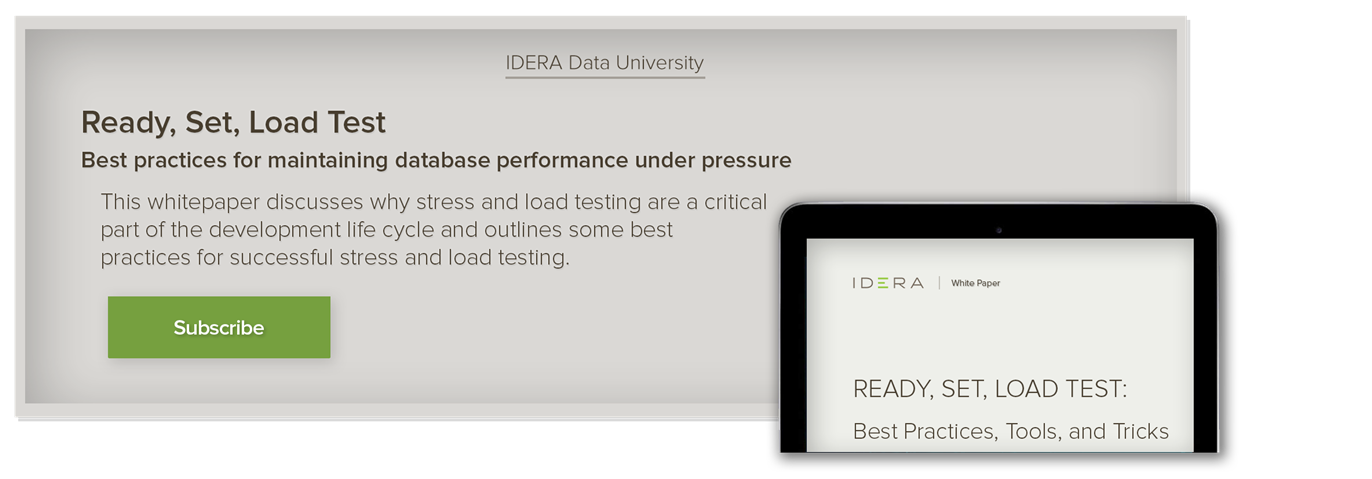Load testing database systems helps prevent performance issues or outages that affect mission-critical database applications.
Modern, data-driven organizations rely on their information technology (IT) environment to make productive use of enterprise information resources. The loss of a key system can be devastating, resulting in substantial financial losses while driving away current and prospective customers.
A method commonly used to minimize issues impacting production applications is the inclusion of test and development systems in the overall IT environment.
The objective is to identify and proactively address potential problems long before systems and applications are released into the production environment. One of the techniques used to ensure that systems can withstand the rigors of production is load testing.
What is Load Testing?
Load testing is the practice of determining how a system or piece of code will behave by simulating its operation under normal and peak usage scenarios. The goal is to identify badly performing code or system bottlenecks in test systems that can be tuned and optimized before they are moved into production.
Performing load testing is essential for applications that experience fluctuating usage patterns. Many businesses experience seasonal changes in the number of users accessing their systems.
Subjecting these systems to excessive loads during testing and development helps eliminate unpleasant surprises when there is a predictable influx of customers during the company’s busy season.
Load Testing vs. Stress Testing
Stress testing is another type of test that simulates the use of a database system to evaluate its fortitude.
The key difference between load testing and stress testing is that the latter purposely subjects a system to higher than normal usage in an attempt to break the system or find problems.
Testing against usage levels that exceed all reasonable expectations, means organizations are prepared for the worst-case scenario.
Additionally, by pushing a system beyond its limits, organizations can analyze how a system might fail and whether it can perform a successful recovery. If the test reveals that scope for successful recovery is limited, the organization may conclude that a more robust recovery plan – such as more regular back-ups – is necessary.
It may seem counterintuitive for database professionals to spend their time trying to break their systems, but it can be the difference between systems that can cope with customer demand and those that fail miserably when a few extra users try to gain access. Companies that depend on their database applications for conducting business benefit from load testing.
Database Load Testing Best Practices
Load testing can be done at various stages in the database and application development cycle. Implementing the following database load testing tips and best practices will help ensure teams are releasing robust applications into production.
- Test early in the development cycle. Developers can focus on load testing individual queries and provide DBAs with documentation verifying that the code is ready for production.
- Automate the load testing process wherever possible. This includes automating the deployment of test environments and the scripts that perform the testing.
- Developers need to consult the business to understand the parts of an application that will be put under pressure by fluctuating user demands. Business analysts should be able to identify the aspects of the application that need to be load and stress tested.
- Run testing scripts that simulate the production environment. When testing specific transactions, start with smaller numbers of simulated users to identify that point at which performance starts to deteriorate.
- Try to cause problems with the systems so they can be resolved. During load testing, the team should expect problems to arise as they increase the workload in an attempt to overwhelm the system’s capabilities.
- Repeat the load testing process as many times as necessary to obtain the proper results. Testing is an iterative activity where the next steps are predicated on the results of previous tests.
A Flexible Tool for Load Testing
DB Optimizer offers database teams a versatile platform for performing load testing and conducting performance tuning on Oracle, SQL Server, Db2, and Sybase systems. A common interface is used for all supported platforms, reducing the learning curve required to use the tool and adding to team productivity.
The tool enables testing to verify the performance of existing SQL queries and proposed alternatives. Queries can be configured to run multiple times to see how they act in a simulated production environment without risking business-critical systems. Reports can be generated so information obtained through the profiling process can easily be shared with colleagues.
With DB optimizer, teams can perform continuous profiling to obtain a graphical representation of wait-time analysis so they can quickly pinpoint performance bottlenecks. The tool’s tuning wizard and Visual SQL Tuning (VST) diagrams lead to efficient SQL code that performs up to expectations.
An IDERA whitepaper is available that covers load testing best practices and tips. It provides valuable information for database teams striving to avoid surprises that negatively impact their critical systems and applications.
DB Optimizer can be purchased as a stand-alone product or as part of the DB PowerStudio suite of database tools that furnish database teams with a variety of solutions to keep their systems operating at peak efficiency.
